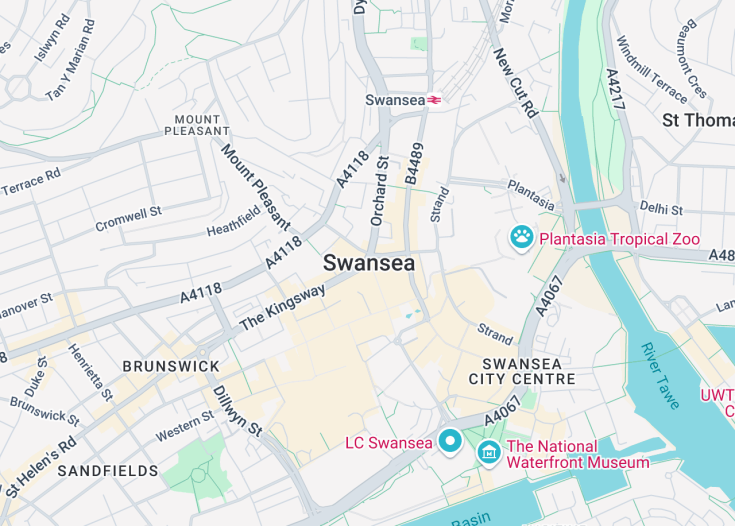Swansea, nestling on the edge of Wales’ breathtaking Gower Peninsula, offers distinctive Welsh culture, captivating maritime quarters, and compelling historical allure. Known as the ‘City of Culture,’ Swansea extends an informative journey through its museums and galleries, complemented by burgeoning culinary scenes and picturesque landscapes.
Beyond urban exploration, the serene Swansea Bay beckons seaside revelers and nature enthusiasts alike.
When visiting Swansea, explore the vibrant Swansea Market for authentic Welsh delicacies, artisan products, and a true taste of local life.
Ensure to spend a day at the Gower Peninsula — Britain’s first Area of Outstanding Natural Beauty — for stunning coastal walks and scenic beach views.
Top things to do & see in Swansea
Select the following sights and activities to discover best tickets and tours available in Swansea.
Swansea: Gateway to the Gower Peninsula
| Country | Wales |
| Time in Swansea | GMT+0 |
| Language spoken | English and Welsh |
| Population | 246,466 (source: latest census data) |
| Currency | Pound Sterling (£, GBP) |
| Airports |
|
Swansea, situated on the southern coast of Wales, offers a unique blend of coastal beauty and historical richness. It serves as a crucial economic and cultural hub within the region. Swansea is renowned for its stunning maritime quarter and the nearby breathtaking Gower Peninsula–the UK’s first designated Area of Outstanding Natural Beauty.
The history of Swansea is rich with industry; it was once a thriving market town primarily known for its wool trade. By the 19th century, it had developed into a major centre for the copper industry, which earned it the nickname ‘Copperopolis’. Today, Swansea continues to celebrate its industrial past while also embracing modern advancements and tourism, which provide a substantial boost to its economy.
Swansea University and Swansea Metropolitan University enhance the city’s educational landscape, attracting students from across the globe. This educational influx has brought an array of cultures and increased the cosmopolitan feel of the city. Culturally, Swansea has produced noted individuals including the famed poet Dylan Thomas, whose work is celebrated in the Dylan Thomas Centre in the Maritime Quarter.
For those who enjoy leisure and arts, Swansea holds regular festivals including the Swansea Festival of Music and the Arts, which is one of the largest festivals of its kind. The city also serves as a gateway to some of the finest beaches in the UK, including Oxwich Bay and Rhossili Bay, which are popular with tourists and locals alike.
Where is Swansea?
Swansea is a coastal city in South Wales, located west of Cardiff and east of Llanelli.
Distances:
| Route | Distance by car | Time by car |
|---|---|---|
| Cardiff to Swansea | 42 miles | 50 minutes |
| Llanelli to Swansea | 13 miles | 20 minutes |
What is Swansea famous for?
Swansea is famous for its historical significance in the copper industry, stunning scenic coastal views, and as the birthplace of Dylan Thomas, one of the greatest poets of the 20th century.
History
Prehistoric Times to Middle Ages
Swansea, located on the southern coast of Wales, has witnessed human activity since prehistoric times. Archaeological discoveries suggest the presence of Stone Age hunter-gatherers in the region, followed by Bronze Age settlers who exploited the natural resources, such as copper and coal. By the time the Romans arrived in the 1st century AD, the area was inhabited by the Celtic tribe, the Silures. Post-Roman times saw the influx of the Saxons and Normans, which led to numerous conflicts and Swansea’s evolution as a fortified town during the Middle Ages.
Industrial Revolution (18th – 19th Century)
The 18th and 19th centuries marked a period of rapid growth for Swansea due to the industrial revolution. It became a key player in the copper industry, earning the nickname ‘Copperopolis’. The port facilities expanded, facilitating trade and the import of raw materials. This era also saw advancements in the steel industry and the development of the Swansea Canal, which played a crucial role in transporting goods.
20th Century to Present
In the 20th century, Swansea faced significant hardship during World War II when it was heavily bombed in the Blitz. The post-war era brought reconstruction and modernisation. Throughout the late 20th and early 21st centuries, Swansea has transformed into a vibrant cultural and educational hub, home to Swansea University and numerous cultural institutions. Presently, it balances its historical heritage with modern developments, continuing to thrive and attract visitors and residents alike.
Visit Swansea
What to see and do in Swansea
Swansea, nestled along the picturesque Gower Peninsula, offers a blend of historical and natural attractions. Explore the enchanting Swansea Castle, wander through the sprawling grounds of Singleton Park, or immerse yourself in art at the Glynn Vivian Art Gallery.
For outdoor enthusiasts, the Gower Peninsula offers breathtaking beaches and coastal walks:
- Oxwich Bay Beach
- Three Cliffs Bay
- Rhossili Bay
Festivals and Events in Swansea
Swansea hosts a variety of events year-round, enriching its cultural landscape. The Swansea International Festival, held in October, showcases a range of musical and theatrical performances.
The summer months are vibrant with the Wales Airshow and the Gower Festival, celebrating local music and culture.
Best time to visit Swansea
The ideal time to visit Swansea is from late spring to early autumn (May to September) when the weather is most favorable for exploring its beaches and outdoor attractions.
Is Swansea worth visiting?
Swansea is undoubtedly worth a visit. From its rich history as a former copper trading hub to its current status as a cultural beacon with universities and festivals, there is much to see and do.
The natural beauty of the Gower Peninsula, coupled with the city’s vibrant events and historical sites, makes Swansea a compelling destination for travelers seeking both cultural immersion and scenic splendor.










